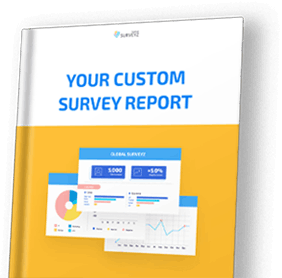As you begin a B2B online survey project, one of the first tasks to check off is determining a goal number of responses: 100, 500, 1,000? It is hard to know what sample size will produce statistically reliable results. What is the golden number of responses that are both cost-effective and achieves the greatest marketing impact?
The short answer is: it depends.
The long answer: there’s a minimum of 100 and typically you won’t need more than 400 survey responses – but factors such as margin of error, cost, respondent criteria, and marketing impact typically can be met at 200 respondents.
We break down each of these factors below.
Hello Margin of Error – Know it, respect it and take it into account
Although we recommend a goal sample size of 200 respondents, there is a more accurate tool available to tell you what number of responses is needed to collect reliable results.
Margin of error is a common measurement used in market research. It tells you how much the survey results align with reality. For example, say we conducted a B2B survey with 100 respondents from a population of 10,000 C-Level executives. The survey results offer a 10% margin on error (see table below). This means that if we found that 80% of companies said they plan to do X in 2021… in reality, the number of companies that will actually do X, is ±10%, which means it’s actually somewhere between 70% to 90%. That’s quite a gap. How can a company adjust their own plans based on such a wide variance? If we sample 400 respondents we’ll reduce the margin error to 5%.
The smaller the margin of error, the more accurate results. As the margin of error starts to increase, the results become less reliable.
Let’s review the table below. It illustrates the amount of respondents needed for a margin of error of ±3%, ±5%, and ±10%.
| Population | Population required per margin error | ||
| Population | ±3% | ±5% | ±10% |
| 500 | 345 | 220 | 80 |
| 1,000 | 525 | 285 | 90 |
| 10,000 | 1,000 | 385 | 100 |
| 100,000 | 1,100 | 400 | 100 |
| 1,000,000 | 1,100 | 400 | 100 |
Table – Population required per margin error
With B2B surveys, we recommend a 5% margin of error. This percentage generates the optimal balance of high-quality and low-cost.
Why it Pays to Play in B2B Market Research
Basing a goal number of responses on a ±3% to ±5% margin of error seems like a no brainer, right? So why aren’t we automatically making that recommendation? Unfortunately, there is a huge cost factor to consider with B2B research. On average, you can expect to pay $20 to $150 per B2B survey response. This is a striking difference from consumer research, where the cost is $1 to $5 per survey response.
Costs also range based on the geography in which you are conducting the online survey. The United States will typically be the most cost-effective location due to the large volume of B2B professionals.
Business decision-makers are typically harder to reach and engage than B2C audiences. It takes higher incentives and recruitment costs to achieve an ideal number of responses. You may want 400 responses for an impressive margin of error, but if you’re going after C-Level execs and need to pay $70 / response, are you willing to pay $28K for that?
Higher job titles = Fewer people = Lower Feasibility
Next, consider the feasibility of your respondent criteria. Say you have the budget for a goal of 400 responses – that’s great, but is it even possible to achieve this number? When conducting B2B surveys with senior executives, the sample size is smaller than most audiences.
Millions of consumers exist across the United States compared to the mere thousands of senior executive B2B professionals. For context, LinkedIn shows us there are 37,000 CMOs and 100,000 VP of marketing. This is a much smaller sample pool compared to the 220,000 Directors of Marketing and 560,000 Marketing Managers.
Additionally, population size isn’t the only factor that impacts project feasibility. Do not be fooled by seeing 100,000 VP of marketing and thinking 400 responses will be easy to achieve.
First, your survey invitation will not be sent to every single VP of marketing in the U.S. Instead, it will be sent to those you have access to via an online panel or customer email list. Second, you are again limited by the number of people who will receive a survey invitation and actually respond.
The calculation for response rate is the number of responses divided by the number of people you invited to respond. On average, B2B response rates range from 5% to 30%.
Segmentation Analysis? You’ll Need A Bigger Sample Size
As we said, 100 responses can be enough for a B2B survey report. However, if during analysis we want to segment the results (small vs. big companies, one country vs. another), we may not be able to do so if we have a handful of responses in each group. Plan segmentation analysis in advance and aim to have 50-100 respondents in each group to be able to provide meaningful insights.
Who you Survey in B2B Beats Margin of Error, Hands-down
There are 1,000 CMOs in the Fortune 1,000. If you want a Margin Error of 3% you’ll need to survey 525 CMOs from the 1,000. That’s not realistic. Should you “downgrade” your audience to Directors of Marketing to get that 3% or should you compromise for a 5% magin by surveying 285 CMOs? Maybe “compromise” on VPs?
While collecting responses from senior level professionals can be expensive, it carries a lot of weight.
Why 200 Responses is the Sweet Spot for B2B Surveys
Generally speaking, we recommend a goal of 200 responses. Why? From a marketing impact perspective, less than 100 responses appears unreliable to readers. From a budget perspective, 400 or more responses is notable but can be very expensive.
For this reason, 200 responses is the sweet spot for B2B surveys. This data point is both impressive and cost-effective. It produces a 5% margin of error that tells readers the data is accurate and reliable. Plus, it has that “wow” factor many B2B surveys are currently missing when they are based on less than 200 responses.
Let’s use a “State of Content Marketing Report” as an example. What description sounds most impressive?
- Insights garnered from 50 Chief Marketing Officers.
- Insights garnered from 200 Marketing Vice Presidents and Directors.
- Insights garnered from 350 Marketing Managers and Coordinators.
The 200 sample size allows companies to obtain quality data from mid-level to senior executives without breaking the bank. It’s a win, win, win.
Final Thoughts
Each online survey project has its own unique objectives, respondent criteria, timeline, budget, and other key performance indicators. For this reason, there is no one size fits all answer to how many responses are necessary for a statistically reliable B2B survey.
In most cases however, 200 responses tends to be the optimum number for B2B market research. It provides businesses with an impressive sample size to create trusted research-driven content without completely draining their marketing budgets.
Conducting B2B surveys is no easy feat, so it’s worth considering working with an experienced third-party. Global Surveyz can design, field, and analyze surveys from any target market. Get a quote for a tailor-made B2B survey today!


